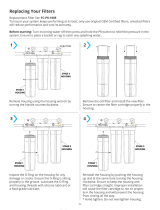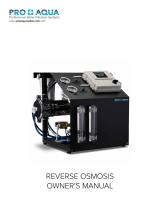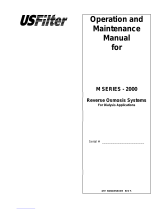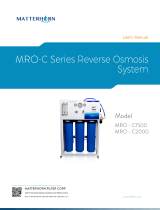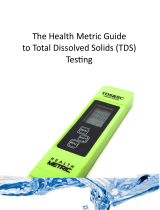Page is loading ...

REVERSE OSMOSIS
INSTALLATION AND OPERATION MANUAL
Model R4X40


IMPORTANT
Please read the entire manual before proceeding with the installation and startup:
Do not use where the water is microbiologically unsafe.
Always turn off the unit, shut off the feed water, and disconnect the electrical power when
working on the unit.
Never allow the pump to run dry.
Never start the pump with the reject valve closed.
Never allow the unit to freeze or operate with a feed water temperature above 100°F.
NOTES
Changes in operating variables are beyond the control of Alamo Water Refiners. The end user is
responsible for the safe operation of this equipment. The suitability of the product water for any
specific application is the responsibility of the end user.
Successful long-term performance of an RO system depends on proper operation and
maintenance of the system. This includes the initial system startup and operational startups and
shutdowns. Prevention of fouling or scaling of the membranes is not only a matter of system
design, but also a matter of proper operation. Record keeping and data normalization are
required in order to know the actual system performance and to enable corrective measures when
necessary. Complete and accurate records are also required in case of a system performance
warranty claim.
Changes in the operating parameters of an RO system can be caused by changes in the feed
water or can be a sign of trouble. Maintaining an operation and maintenance log is crucial in
diagnosing and preventing system problems. For your reference, a typical log sheet is included
in this manual.

TABLE OF CONTENTS
I. Introduction
A. Specifications
B. RO Overview
C. Pre-treatment
II. Controls, Indicators, and Components
III. Operation
A. Installation
B. Plumbing Connections
C. Electrical
D. Startup
E. Control Function
F. Operation and Maintenance Log
G. Troubleshooting
IV. Replacement Parts List
V. Membrane Replacement
VI. Appendix
Temperature Correction Factors

I. INTRODUCTION
The separation of dissolved solids and water using RO membranes is a pressure driven
temperature dependent process. The membrane material is designed to be as permeable to water
as possible, while maintaining the ability to reject dissolved solids.
The main system design parameters require the following:
Internal flows across the membrane surface must be high enough to prevent settling of fine
suspended solids on the membrane surface.
The concentration of each dissolved ionic species must not exceed the limits of solubility
anywhere in the system.
Pre-treatment must be sufficient to eliminate chemicals that would attack the membrane
materials.
A. SPECIFICATIONS
Notes:
Maximum production based on a feed water of 77°F, SDI < 1, 1000 ppm TDS, and pH 7.
Individual membrane productivity may vary (± 15%). May be operated on other feed waters with reduced
capacity.
Percent Rejection is based on membrane manufactures specifications; overall system percent rejection may
be less.
R4X40-1 R4X40-2 R4X40-3
Maximum Productivity (gallons per day) 2200 4400 6600
Quality (average membrane rejection) 98 %
Recovery (user adjustable) 15 - 75 % 25 – 75% 32 - 75 %
Membrane Size
4” x 40”
Number Of Membranes
1 2 3
Prefilter (system ships with one 5 micron cartridge) 20”
Feed Water Connection
3/4" NPTF
Product Water Connection (tubing OD) 5/8"
Reject Water Connection (tubing OD) 5/8"
Feed Water Required (maximum) 10 gpm 12 gpm 14 gpm
Feed Water Pressure (minimum) 10 psi
Drain Required (maximum) 10 gpm 12 gpm 14 gpm
Electrical Requirement (120 VAC 60 Hz)
8 amps 12 amps 16 amps
Motor Horse Power
3/4 1 1 1/2
Dimensions W x D x H (approximate inches) 20 x 20 x 50 20 x 26 x 50
Shipping Weight (estimated pounds) 120 150 180

B. RO OVERVIEW
Reverse osmosis systems utilize semipermeable membrane elements to separate the feed
water into two streams. The pressurized feed water is separated into purified (product) water
and concentrate (reject) water. The impurities contained in the feed water are carried to drain
by the reject water. It is critical to maintain adequate reject flow in order to prevent
membrane scaling and/or fouling.
RO Membrane
Feed Water Product Water
Reject Water
C. PRETREATMENT
The RO feed water must be pretreated in order to prevent membrane damage and/or fouling.
Proper pretreatment is essential for reliable operation of any RO system.
Pretreatment requirements vary depending on the nature of the feed water. Pretreatment
equipment is sold separately. The most common forms of pretreatment are described below.
Media Filter - Used to remove large suspended solids (sediment) from the feed water.
Backwashing the media removes the trapped particles. Backwash can be initiated by time or
differential pressure.
Water Softener - Used to remove calcium and magnesium from the feed water in order to prevent
hardness scaling. The potential for hardness scaling is predicted by the Langelier Saturation
Index (LSI). The LSI should be zero or negative throughout the unit unless approved anti-
scalents are used. Softening is the preferred method of controlling hardness scale.
Carbon Filter - Used to remove chlorine and organics from the feed water. Free chlorine will
cause rapid irreversible damage to the membranes.
The residual free chlorine present in most municipal water supplies will damage the thin film
composite structure of the membranes used in this unit. Carbon filtration or sodium bisulfite
injection should be used to completely remove the free chlorine residual.
Chemical Injection
- Typically used to feed antiscalant, coagulant, or bisulfite into the feed water
or to adjust the feed water pH.

Prefilter Cartridge - Used to remove smaller suspended solids and trap any particles that may be
generated by the other pretreatment. The cartridge(s) should be replaced when the pressure drop
across the housing increases 5 - 10 psig over the clean cartridge pressure drop.
The effect of suspended solids is measured by the silt density index (SDI) test. An SDI of five
(5) or less is specified by most membrane manufacturers and three (3) or less is recommended.
Iron & Manganese - These foulants should be removed to less than 0.1 ppm. Special media
filters and/or chemical treatment is commonly used.
pH - The pH is often lowered to reduce the scaling potential. If the feed water has zero hardness,
the pH can be raised to eliminate CO2.
Silica: Reported on the analysis as SiO2. Silica forms a coating on membrane surfaces when the
concentration exceeds its solubility. Additionally, the solubility is highly pH and temperature
dependent. Silica fouling can be prevented with chemical injection and/or reduction in recovery.
II. CONTROLS, INDICATORS, and COMPONENTS (see figure 1)
A. On / Off Switch – Turns the unit on and off.
B. Low-pressure indicator – Turns on when low pump inlet pressure is detected.
C. Reject Control Valve - Controls the amount of reject flow.
D. Reject Recycle Control Valve – Controls the amount of recycle flow.
E. Prefilter Outlet Pressure Gauge - Indicate the outlet pressures of the prefilter.
F. Pump Discharge Pressure Gauge - Indicates the membrane feed pressure.
G. Reject Flow Meter - Indicates the reject flow rate in gallons per hour (gph).
H. Product Flow Meter - Indicates the product flow rate in gallons per hour (gph).
I. Prefilter Housing - Contains the RO prefilter.
J. RO Feed Pump - Pressurizes the RO feed water.
K. RO Membrane Housing(s) - Contains the RO membrane(s).
L. Water Quality Meter – Indicates the quality of the feed and product water in parts per
million of total dissolved solids (PPM – TDS).
M. Feed Water Inlet.

Figure 1
A
M
B
CD
E
F
GH
I
J
K
L

III. OPERATION
A. INSTALLATION
1. Proper pretreatment must be determined and installed prior to the RO system.
2. The water supply and pretreatment equipment should be sufficient to provide a
minimum of 10-psig at the maximum feed flow.
3. An electrical receptacle with a ground fault interrupt (GFI) is highly recommended.
4. Responsibility for meeting local electrical and plumbing codes lies with the owner /
operator.
5. Install indoors in an area protected from freezing. Space allowances for the removal
of the membranes from the pressure vessels should be provided.
6. Verify that a prefilter cartridge is installed in the housing. (see figure #1, item I).
B. PLUMBING CONNECTIONS
Note: It is the responsibility of the end user to ensure that the installation is done according to
local codes and regulations.
1. Connect the pretreated feed water line to the prefilter inlet (Figure # 1 item M). A
feed water shutoff valve should be located within 10 feet of the system.
2. Temporarily connect the product water outlet to a drain. The product outlet is located
behind the panel at the top of the product flow meter. The product water line should
never be restricted. Membrane and/or system damage may occur if the product line is
blocked.
3. Connect the reject water outlet to a drain. The reject outlet is located behind the
panel at the top of the reject flow meter. The reject drain line should never be
restricted. Membrane and/or system damage may occur if the reject drain line is
blocked. An air gap must be located between the end of the drain line and the drain.
The use of a standpipe or other open drain satisfies most state and local codes and
allows for visual inspection and sampling.
C. ELECTRICAL
Note: It is the responsibility of the end user to ensure that the installation is done according to
local codes and regulations.
1. Make sure the on / off switch in the off position (Figure # 1 item A).
2. Plug the unit into a standard 120 volt 3 prong outlet. An outlet protected with a
ground fault interrupt (GFI) is recommended.

D. STARTUP
1. Verify that the pretreatment equipment is installed and working properly. Verify that no
free chlorine is present in the feed water.
2. Verify that the on / off switch is in the off position.
3. Verify that a filter cartridge is installed in the prefilter housing.
4. Open the reject control valve completely (Figure # 1 item C) by turning it
counterclockwise.
5. Close the reject recycle control valve (Figure # 1 item D) completely by turning it
clockwise.
6. Open the feed water shutoff valve installed in step III-B-1 above.
7. Move the controller on/off switch to the on position.
8. Allow the unit to run for 15 – 30 minutes to flush the preservative from the membrane(s).
9. Adjust the reject control valves (Figure # 1 items C & D) until the desired flows are
achieved. Closing the reject valve increases the product flow and decreases the reject
flow. Opening the reject recycle valve decreases both the reject and product flow. See
the flow rate guidelines and temperature correction table in the appendix to determine the
flow rates for different operating temperatures.
10. Allow the product water to flow to drain for 30 minutes.
11. Turn off the system and connect the product line to the point of use. The product water
line should never be restricted. Membrane and/or system damage may occur if the
product line is blocked.
12. Restart the system and record the initial operating data using the log sheet.
E. CONTROL FUNCTION
1. When the on / off switch is in the on position, the inlet valve opens and the pump runs. If
the water pressure feeding the pump drops below 10 psi for more than 5 seconds, the
pump will turn off and the amber light on the control box will turn on. The controller
will automatically reset after 30 minutes and the pump will turn back on. Cycle the on /
off switch to manually reset a low-pressure shutdown.
2. Quality Meter – The quality meter measures the feed water and product water total
dissolved solids (TDS) in parts per million (PPM). The lower the TDS the more pure the
water is. To check the TDS press the power button, then pres either the IN or OUT
button. The IN button checks the feed water TDS and the OUT button checks the
product water TDS. The meter will automatically turn it self off after a few seconds.
The quality meter is powered by two AAA batteries. To replace the batteries, lift the
meter out of the bracket and remove the back cover.

F. Operation and Maintenance Log
DATE PRODUCT
GPM
REJECT
GPM
PUMP
DISCHARGE
PRESSURE
FEED
TDS
PPM
PRODUCT
TDS
PPM
FEED
WATER
TEMP
FEED
WATER
HARDNESS
FEED WATER
CHLORINE
LEVEL
PRE FILTER
INLET
PRESSURE
PRE FILTER
OUTLET
PRESSURE
REMARKS
Note: Change the prefilter when the differential pressure increases by 5 - 10 psi over the clean differential pressure.
Clean the RO membrane(s) when the product flow drops by 15% or more. (See appendix)

G. TROUBLESHOOTING
RO MEMBRANE TROUBLE SHOOTING GUIDE
SYMPTOMS
Salt Passage Permeate Flow Pressure Drop Location Possible Causes Verification Corrective Action
Normal to
increased
Decreased Normal to
increased
Predominantly
first stage
Metal oxide Analysis of metal
ions in cleaning
solution.
Improved pretreatment
to remove metals.
Cleaning with acid
cleaners.
Normal to
increased
Decreased Normal to
increased
Predominantly
first stage
Colloidal fouling SDI measurement
of feed/ X-ray
diffraction
analysis of
cleaning sol.
residue.
Optimize pretreatment
system for colloid
removal. Clean with
high pH, anionic
detergent formulation.
Increased
Decreased Increased Predominantly
last stage
Scaling
(CaSO
4
, CaSO
3
,
BaSO
4
, SiO
2
)
Analysis of metal
ions in cleaning
sol. Check LSI of
reject. Calculate
maximum
solubility for
CaSO
4
, BaSO
4
,
SiO
2
in reject
analysis.
Increase acid addition
and scale inhibitor for
CaSO
3
and CaSO
4
.
Reduce recovery.
Clean with an acid
formulation for
CaCO
3
, CaSO
4
and
BaSO
4
.
Normal to
moderate
increase
Decreased Normal to
moderate
increase
Can occur in
any stage
Biological fouling
Bacteria count in
permeate and
reject. Slime in
pipes and vessels.
Shock dosage of
sodium bisulfite.
Continuous feed of
low conc. bisulfite at
reduced pH. Peracetic
acid sterilization.
Clean with alkaline
anionic surfactant.
Chlorine dosage up-
stream with
dechlorination.
Replace cartridge
filters.
Decreased or
moderately
increased
Decreased Normal All stages Organic fouling Destructive
testing, e.g. IR
reflection
analysis.
Optimization of
pretreatment system
(e.g. coagulation
process.)
Resin/activated carbon
treatment. Clean with
high pH detergent.
Increased Increased Decreased Most severe in
the first stage
Chlorine oxidant
attack
Chlorine analysis
of feed.
Destructive
element test.
Check chlorine feed
equipment and
dechlorination
equipment.
Increased Increased Decreased Most severe in
the first stage
Abrasion of
membrane by
crystalline material
Microscopic
solids analysis of
feed. Destructive
element test.
Improved
pretreatment. Check
all filters for media
leakage.
Increased Normal to
increased
Decreased At random O-ring leaks, End
or side seal glue
leaks.
Probe test.
Vacuum test.
Colloidal
material passage.
Replace O-rings.
Repair or replace
elements.
Increased Normal to low Decreased All stages Conversion too
high.
Check flows and
pressures against
design guidelines
Reduce conversion
rate. Calibrate sensors.
Increase analysis and
data collection.

RO SYSTEM TROUBLE SHOOTING
PROBLEM REMEDY
General
High Product Water TDS
Membrane frozen, high temp, or backpressure. Replace membrane.
Membrane attack by chlorine Carbon pre-filter may be exhausted. Replace filter and membrane.
Product seal on end cap. Determine if seal or o-ring is bad. Replace as needed.
No Product Water or Not Enough Product Water
Feed water shut off. Turn on feed water.
Low feed pressure. Feed pressure must be at least 10 psi. Consider booster pump.
Pre-filter cartridge clogged. Replace pre-filter cartridge.
Membrane fouled. Determine and correct cause; replace or clean membrane.
Product check valve stuck. Clean or replace check valve.
Low pump discharge pressure
Low feed water temperature
Adjust reject valve or replace pump
Increase membrane feed pressure or heat the feed water.
IV. REPLACEMENT PARTS LIST
A list of common replacement parts is provided below. Contact your dealer for replacement
parts assistance.
Part Number Description
FPMB5-20 Prefilter, 5 micron, melt blown
R9622-WLE RO membrane, low energy
R2451 Prefilter pressure gauge 0 – 100 psi
PG20B25 Pump discharge pressure gauge 0 – 300 psi
R4507 Product flow meter 0.5 – 5 gpm
R5316 Reject flow meter with valve 0.5 – 5 gpm
WDM-2 Water quality meter
R6316-HPS7D Pump & motor 0.75 HP for R4X40-1
R6316-HPS7E Pump & motor 1.0 HP for R4X40-2
R6316-HPS10F Pump & motor 1.5 HP for R4X40-3
R23-1070S Controller with on/off switch (R4X40-1)
R23-1072S Controller with on/off switch (R4X40-2 & R4x40-3)
R2316-PS32 Low pressure switch, ¼” MPT
T1100 Recycle needle valve PVC
R2482-120 Inlet solenoid valve, ¾”, 120 volt coil
R96-PV-4040-OS Pressure vessel with end caps, 316 SS

V. MEMBRANE REPLACEMENT
1. Turn off the system and close the feed water shutoff valve.
2. Unplug the unit.
3. Disconnect the tubing from the top of the membrane housing(s).
4. Loosen the clamps and remove the top end cap(s).
5. Remove the old membrane(s) by pulling them up and out of the housings. You may
need to grab the old by the membrane with a pair of pliers.
6. Install the new membrane(s) in the housing(s) and replace the end caps. The new
membranes should be installed in the same orientation as the old membranes.
Note: It is very important that the brine seal does not flip up or roll when installing
the membrane brine seal first. Use plenty of glycerin lubricant and use a gentle
twisting / rocking motion as you slide the membrane in. If you are unable to install
the membrane brine seal first without rolling the seal then lay the unit over, remove
the bottom end cap, and install the membrane brine seal last.
7. Reconnect the tubing to the bottom of the membrane housing(s).
8. Follow the start up procedure in section III-D.

VI. APPENDIX
The following tables are intended as a guide to determining the flow rates for the R4X40
series RO systems. All flows are in gallons per minute (GPM) with 77°F feed water.
Nominal flows for systems operating at 50% recovery with a feed water SDI < 1.
R4X40-1 R4X40-2 R4X40-3
Product GPM 1.5 3.0 4.5
Reject GPM 1.5 3.0 4.5
Nominal flows for systems operating at 50% recovery with a feed water SDI < 3.
R4X40-1 R4X40-2 R4X40-3
Product GPM 1.25 2.5 3.75
Reject GPM 1.25 2.5 3.75
Nominal flows for systems operating at 50% recovery with a feed water SDI 3 to < 5.
R4X40-1 R4X40-2 R4X40-3
Product GPM 1 2 3
Reject GPM 1 2 3

Temperature Correction Factors
Deg C Deg F Correction Factor
25 77 1.00
24 75.2 0.97
23 73.4 0.94
22 71.6 0.92
21 69.8 0.89
20 68 0.86
19 66.2 0.84
18 64.4 0.81
17 62.6 0.79
16 60.8 0.77
15 59 0.74
14 57.2 0.72
13 55.4 0.70
12 53.6 0.68
11 51.8 0.66
10 50 0.64
9 48.2 0.62
8 46.4 0.61
7 44.6 0.59
6 42.8 0.57
5 41 0.55
Multiply the nominal product flow at 25° C by the temperature correction factor to determine the
flow at various other temperatures.
/
